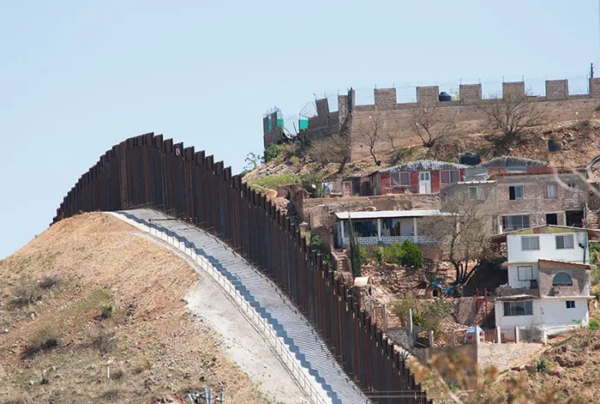
By Jay Jason Bartlett
The government and the general public have long been extremely concerned about the physical security of the United States’ borders. The security of the borders, which comprise the coastline and the northern and southern borders, is crucial for the safety and development of the nation since they serve as important points of entry for both products and people.
With almost 5,500 miles of border with Canada to the north and 1,900 miles with Mexico to the south, the United States has the longest land border in the whole globe. The United States has nearly 12,000 miles of coastline in addition to these land borders. It is difficult to ensure the security of every entrance point with so many of them.
Many reasons, including illegal immigration, drug trafficking, human smuggling, terrorism, and other criminal activities, contribute to the multifaceted and complicated security concerns along the US borders. Thus, the government has put in place a number of measures, such as border barriers, surveillance technologies, and more border patrol agents, to improve the physical security of the frontiers.
The building of a physical barrier between the United States and Mexico is one of the most divisive actions made to enhance border security. A 450-mile-long wall was erected along the southern border during the previous administration of former President Donald Trump in places where there was no existing physical barrier.
Advocates of the wall contend that by making it more difficult for people to cross the border, the wall helps prevent illegal immigration and drug trafficking. Opponents counter that the wall is ineffectual and expensive since it is prone to breaches and that resources would be better spent on more effective security measures like cutting-edge surveillance equipment.
Technology for border surveillance is also quite important.
To identify and stop threats at the border, U.S. Customs and Border Protection (CBP) makes use of a variety of cutting-edge technologies including drones, surveillance cameras, various sensors, and radars are just a few of these technologies. They aid in border surveillance, identify questionable activity, and give border patrol officials up-to-the-minute intelligence.
The CBP is using drones more frequently to improve border surveillance.
These are unmanned aerial vehicles that can take pictures and videos of the border from above and are fitted with cameras and other sensors. They can also be used to identify and follow illicit operations like the trafficking of drugs and smuggling of people. Drones are an effective tool for border protection since they can quickly cover large areas. Also, the CBP keeps an eye on the border with cameras and sensors.
Real-time photographs and videos of the border can be captured by these cameras, giving border patrol officials important information. Contrarily, sensors are able to pick up on shady activities including illicit border crossings and the movement of trucks and ships.
The CBP uses radar equipment in addition to cameras and sensors to keep an eye on the airspace around the border. The border patrol agents will receive an early warning if the radar picks up any airborne threats, like as aircraft or drones. Also, it enables the CBP to detect drug trafficking and other illegal activity by tracking the movement of vessels in the ocean.
The number of border patrol agents is a key element in enhancing border security.
The CBP, which has over 20,000 border patrol personnel on staff, is in charge of protecting the American borders. These officers are in charge of border patrol, stopping illicit activity, and implementing immigration regulations.
For the CBP, finding and keeping border patrol agents has proven to be difficult.
Both the work environment and the job are physically demanding. Due to the large number of Spanish-speaking people who enter the southern border, the position also demands fluency in Spanish.
Cooperation with neighbors, particularly Mexico and Canada, is necessary to ensure the physical security of U.S. borders. To increase border security, the U.S. has created many bilateral agreements with these nations. These agreements call for exchanging intelligence, working together to patrol, and other measures to safeguard the border as effectively as feasible given the resources at hand.
After the terrorist attacks of 9/11/2001, there have been many attempts to solve the different physical security challenges that exist at the U.S. borders.
Some of the border physical security challenges in the United States include:
Unauthorized immigration
One of the biggest threats to physical security at the US borders is illegal immigration.
Many thousands of people seek to enter the country illegally each year, frequently risking their lives. A sizable number of people cross the border illegally each year, making the U.S.-Mexico border particularly susceptible to illegal immigration.
CBP monitors the borders using a variety of equipment, including ground sensors, drones, and surveillance cameras. Also, CBP officers are posted at the borders to deter unauthorized entry into the nation.
Notwithstanding these initiatives, physical border security remains a serious problem for the United States. The U.S.-Mexico border is enormous, making it challenging to fully protect, and many places’ harsh terrain makes it simple for people to cross undetected. Also, it is difficult for
CBP personnel to stop everyone due to the sheer number of people attempting to cross the border illegally.
Drug Trafficking
Another serious threat to physical security at the US borders is drug trafficking. Drug cartels from Mexico and other nations exploit the US borders as a point of entry to get drugs into the country. The drugs are frequently delivered by people, shipped in cargo containers, or disguised in cars.
CBP is in charge of stopping drugs at U.S. borders.
The organization employs a variety of methods, such as drug-sniffing dogs, X-ray machines, and body scanners, to find drugs. Agents of CBP collaborate with the Drug Enforcement Administration (DEA) and other law enforcement organizations to stop drugs from entering the nation.
Drug trafficking continues to pose a serious threat to physical security at U.S. borders notwithstanding these measures. It is difficult for CBP inspectors to stop all drugs from entering the nation because of the vast number of persons and vehicles that cross the borders every day. Also, it is challenging for law enforcement organizations to keep up with the drug cartels’ continual development of new strategies for bringing drugs into the country.
Terrorism
Another serious threat to physical security at U.S. borders is terrorism. The U.S. borders are frequently used by terrorists to enter the nation and commit attacks. For instance, terrorists who entered the country legally but overstayed their visas carried out the 9/11 attacks.
Terrorists entering the nation must be stopped, according to CBP.
The agency employs a variety of strategies, like as watchlists, biometric screening, and sophisticated passenger information systems, to find prospective terrorists.
In order to find and detain possible terrorists, CBP officers collaborate with other law enforcement organizations, such as the Federal Bureau of Investigation (FBI).
Terrorism still poses a serious threat to physical security at U.S. borders notwithstanding these efforts. Terrorists are continuously changing their strategies and coming up with new ways to sneak into the country. Also, it is difficult for CBP personnel to spot potential terrorists due to the enormous volume of people entering the nation every day.
Border Barricades
The US government must spend money on a strong and reliable border barrier in order to handle the physical security issue of border fencing. To ensure efficacy, the border fence should be built with cutting-edge tools and materials. In order to eliminate gaps that criminals and smugglers could exploit, the barrier should also be routinely maintained and mended.
Technology and Equipment
The US government must make investments in cutting-edge and efficient technology and equipment for the Border Patrol to solve the issue of physical security. This includes cutting-edge surveillance equipment, sensors, and drones that can spot and stop border crossings that are illegal as well as other criminal activity.
Money is a significant overarching issue that affects physical security at all international borders, including those of the United States and every other nation. Simply put, the expenditures involved in securing and guarding its borders are enormous. Protecting one’s borders must be a top priority as a matter of national security, despite the fact that problems and difficulties may still arise.
Other resources to research border security include:
- Department of Homeland Security: https://www.dhs.gov/topic/border-security
- Customs and Border Protection: https://www.cbp.gov/border-security
- Homeland Security Digital Library: https://www.hsdl.org/?s=border+security
- Federation of American Scientists: https://fas.org/sgp/crs/homesec/R42138.pdf
- Migration Policy Institute: https://www.migrationpolicy.org/topics/border-security
- Center for Immigration Studies: https://cis.org/Border-Security
- Border Security Report: https://www.border-security-report.com/
- Migration Information Source: https://www.migrationpolicy.org/topics/border-enforcement

Cozaint Corporation is a service-disabled veteran owned business that builds software and hardware intelligent surveillance solutions. Physical security kiosks and video surveillance storage systems that deliver 24/7/365 surveillance and peace-of-mind. When you need leading edge physical security solutions, lean on Cozaint. visit: www.Cozaint.com

Jay Jason Bartlett is the Managing Editor of Security.World and the CEO of Cozaint Corporation, a manufacturer of security surveillance solutions. Jay has over 40 years in the high-tech industry and over 15 years in physical security. visit: cozaint.com
See more articles on Cozaint Corporation
Source: cozaint.com
Source: cozaint.com
